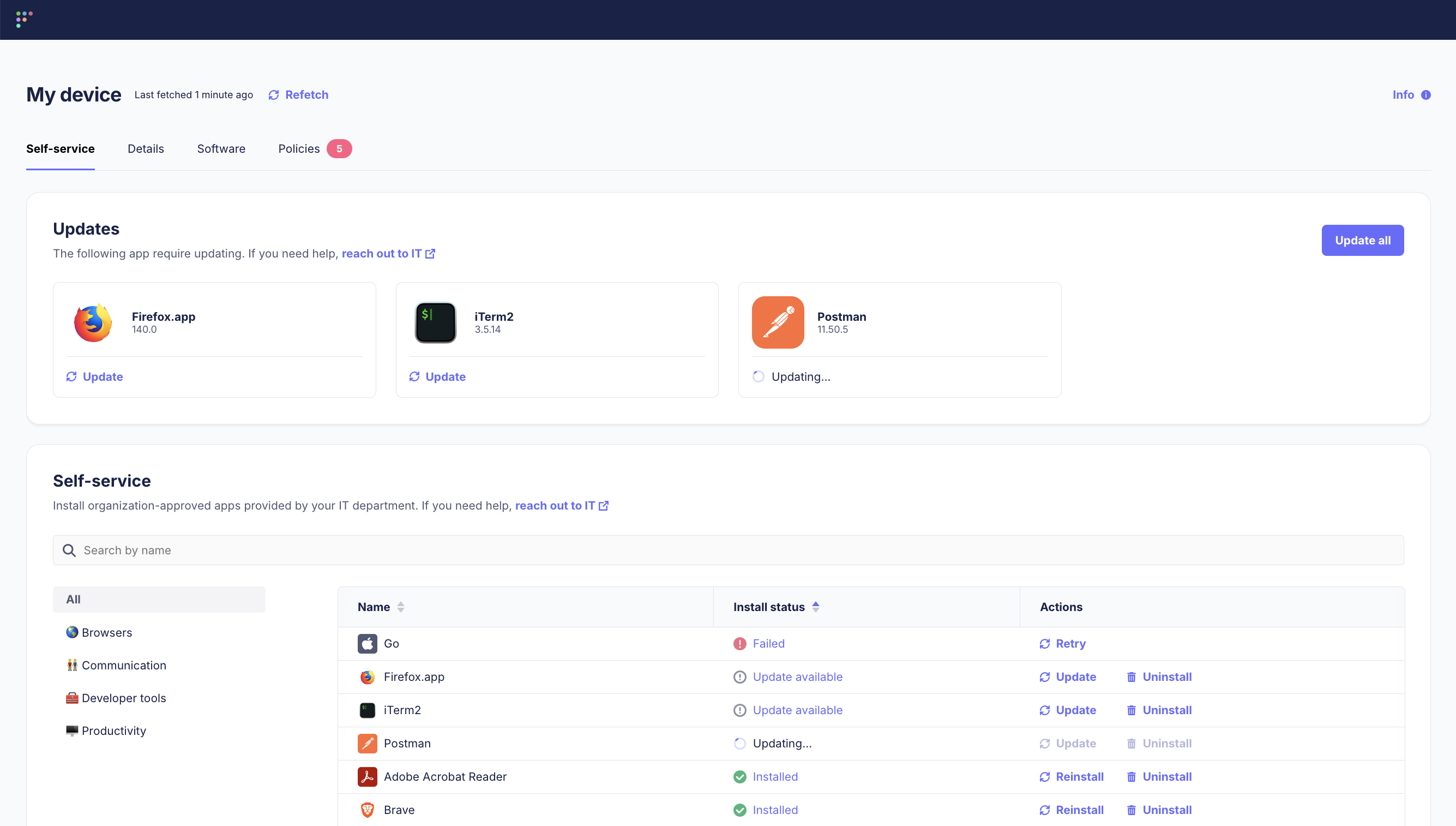Software self-service
{{articleSubtitle}}
Jahziel Villasana-Espinoza
Software self-service
{{articleSubtitle}}
Jahziel Villasana-Espinoza
Software self-service

Available in Fleet Premium
Fleet’s self-service software lets end users update and install approved apps from a curated list on the Fleet Desktop > Self-service page. This reduces overhead for IT and keeps teams productive. This guide covers how to add, install, and update self-service software in Fleet.
Add software
- Select the team to which you want to add the software from the dropdown in the upper left corner of the page.
- Select Software in the main navigation menu.
- Select the Add software button in the upper right corner of the page.
- Pick a Fleet-maintained app, app store app, or upload a custom package.
- Check Self-service to make it available for self-service as soon as it's added.
You can also add the software and later make it available in self-service:
- Select the team to which you added the software from the dropdown in the upper left corner of the page.
- Select Software in the main navigation menu.
- Select the All software dropdown and choose Available for install. This filters the results in the table to show only software that can be installed on hosts. If you don’t see your software, page through the results or search for your software's name in the search bar. Once you find the software, select its title.
- Select the pencil (edit) icon and check Self-service in the Options section. You can also assign categories and add a custom icon. Icons appear on the My device > Self-service page. Custom icons are only available for custom packages and app store apps.
- Select the Save button.
If a software item isn't made available in self-service, end users will not see it in Fleet Desktop > Self-service. IT admins can still install, update, and uninstall the software from Fleet.
IT admin experience
How to view, update, install, or uninstall self-service software:
- Go to Hosts.
- Select a host to go to the Host details page.
- Open the Software > Library tab and select Self-service in the dropdown.
- To update, install, or uninstall, select Update, Install, or Uninstall.
Update appears for eligible updates, regardless of whether the app is set to self-service.
Tips:
- Use the Software > Library table to quickly identify and action pending updates.
- When a software install or uninstall fails, select Failed to see error details that can help with troubleshooting.
- To automatically install software, you can use Fleet's policy automations. Learn how.
End user experience
How to update, install, or uninstall self-service software:
- Find the Fleet icon in your menu bar and select Self-service. This will open your default web browser to the list of self-service software available to update, install, or uninstall.
- If updates are available, end users can update one or all available self-service software. They can also view update progress and error details directly.
API
Fleet provides a REST API for managing software, including self-service software packages. Learn more about Fleet's REST API.
GitOps
To manage self-service software using GitOps, see the software key in the GitOps reference documentation.
Note: When managing Fleet via GitOps, software packages uploaded using the web UI persist only if they are also defined in GitOps with the
hash_sha256field.
Advanced
How updates work
When Fleet shows Update instead of Install:
- The software is detected in Fleet's software inventory (software installed on the host).
- Fleet has a newer version of the software. This version is newer than at least one version of the software in Fleet's software inventory.
Currently, if a host has two versions of the software installed, with each version installed in different locations, Fleet can only upgrade one version. In this scenario, Fleet will still show Update. If this happens, the best practice is to run a custom script to uninstall the old version. Here's an example script that removes a copy of Google Chrome present in a macOS host's Downloads/ folder:
rm -r /Users/noahtalerman/Downloads/Google\ Chrome.appFor more technical detail and edge cases, refer to the software self-service diagram.
Statuses
When an install, uninstall, or update is triggered by an IT admin or end user in the Fleet UI or by an end user—Fleet continuously monitors ("polls") and surfaces a loading status (e.g., "Installing...").
- If the host is online, Fleet will poll automatically every 5 seconds to check for completion. When the install, uninstall, or update completes or fails, the status will update without the IT admin or end user having to reload the page.
- If the host is offline, IT admins see a pending status. When pending, the action has not started on the host. IT admins can cancel pending actions on Host details > Activity > Upcoming tab.







